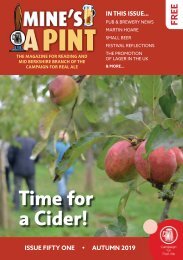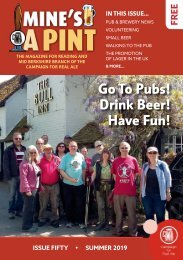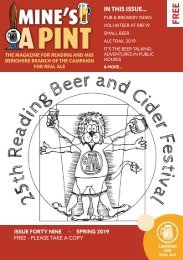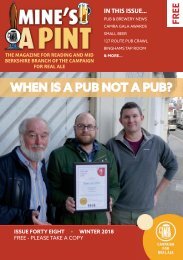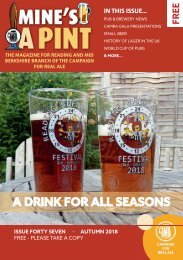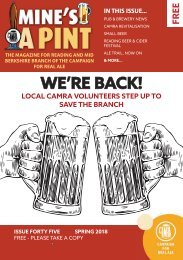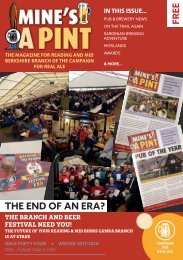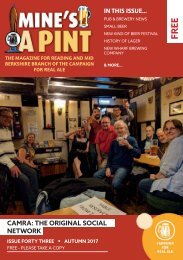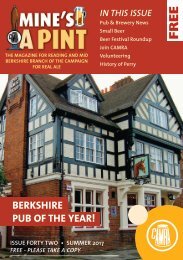Mine's a Pint - Spring 2020
The Spring 2020 edition of the magazine of the Reading & Mid-Berkshire Branch of the Campaign for Real Ale (CAMRA).
The Spring 2020 edition of the magazine of the Reading & Mid-Berkshire Branch of the Campaign for Real Ale (CAMRA).
Create successful ePaper yourself
Turn your PDF publications into a flip-book with our unique Google optimized e-Paper software.
Until the 1940s, the printer’s name quite often
appeared but, as quickly as the trend for thinner
and smoother mats became evident, the identity
of the printer became less so. As late as 1960,
Worthington & Company issued a set depicting
six notable personages in both embossed and
smooth board versions. And, therein lies the
appeal of beer mat collecting, encouraged
by the brewers themselves, consciously in
supplying variations on a theme which are
eminently collectable in themselves (the subject
matter) and, unconsciously, by employing
different manufacturers to produce and print
them (the raw material).
Should a printer’s mark, if not a full name, be
apparent, this is an invaluable aid in dating
a particular mat. More often, it is a case of
identifying as accurately as possible when
a particular ale was available or a specific
advertising campaign was underway.
Most beer or drip mats are individual rather
than parts of sets and tend to reflect the mood of
the period and, thus in their own, unique, way
record history, particularly brewery history.
For example, in 1933, when the Watney,
Combe, Reid & Company finally attempted to
rationalise their respective trademarks of a stag,
a malt rake and a griffin respectively (they’d
amalgamated a mere 35 years earlier!), they
organised a national competition with a first
prize of £500 to find a new corporate identity
motif. From 26,000 entries, a Mr Ranklin won
with a simple ‘red barrel’ device and the rest, as
they say, is history.
Conversely, when Ind Coope merged with
Samuel Allsopp in 1934, the fortress-like
building associated with the former was
phased out completely and Allsopp’s ‘red hand’
became adopted by both concerns and even
continued after the name Allsopps was dropped
completely from beer mats c. 1950.
After Courage & Co. Ltd. merged with Barclay,
Perkins & Co. Ltd. in 1955, mats began to
be issued jointly illustrating the cockerel of
Courage alongside the Dr. Johnson device
used by Barclays. But, upon this company
in turn merging with H. & G. Simonds Ltd.
of Reading, mats initially bore the titling of
‘Courage, Barclay & Simonds Ltd.’ before
the ‘Courage’ branding became predominant
and the identities of its other constituent
companies, including Simonds’ hop leaf motif,
became consigned to history. However, since
the emergence of the Campaign for Real Ale,
a renewed interest in traditional ale meant that
many of the remaining breweries were less
ashamed of their previous takeover activities
and began to reissue beer mats that recalled past
beers when these were revived along with their
originating brewer’s names where appropriate
such was the impetus of both nostalgia and the
need for some marketing nous.
Probably, the first
collectable set of mats
issued in the UK were
by Bass, Worthington,
Ltd. in 1928 which
featured a character
called ‘Bill Stickers’
and the craze for
issuing complete sets
probably reached its zenith with three series of
large-sized sets of 15 each by Ind Coope Ltd.
in the late-1970s that, between them, told the
‘Story of Beer’. Their issue encapsulates all the
appeal of beer mat collecting. There were two
No. 1s in the first 1976 series since, apart from
the official No. 1, that number was additionally
used as invitations to Burton Ale sampling
sessions which differed by dates and venues.
And, there were two No. 9s since the original
wording on the first version proved contentious
as it had stated, ‘thus keg beer was more
dependable but said to have less ‘character’ than
cask beer’. As Ind Coope produced the most
widely-available keg beer at the time – Double
Diamond – and that this assertion was only an
‘opinion’ – by a CAMRA mole in Allied’s HQ
perhaps? – this mat only appeared well after all
the others with the wording changed to, ‘cask
beer and keg beer co-existed each enjoying its
own popularity’.
Mine’s A Pint
17







